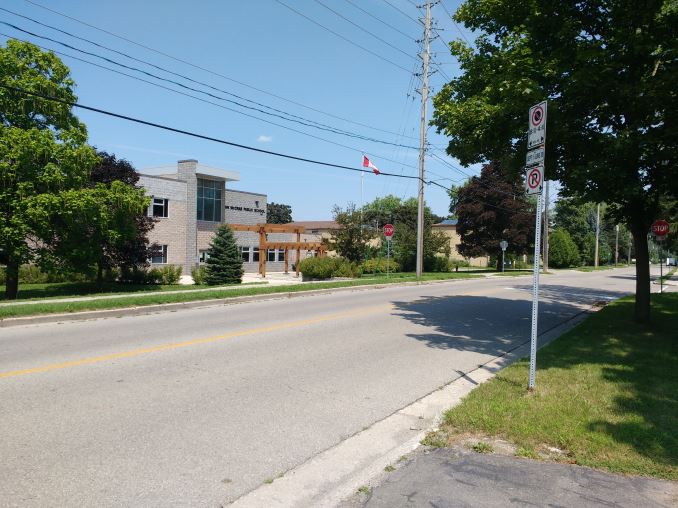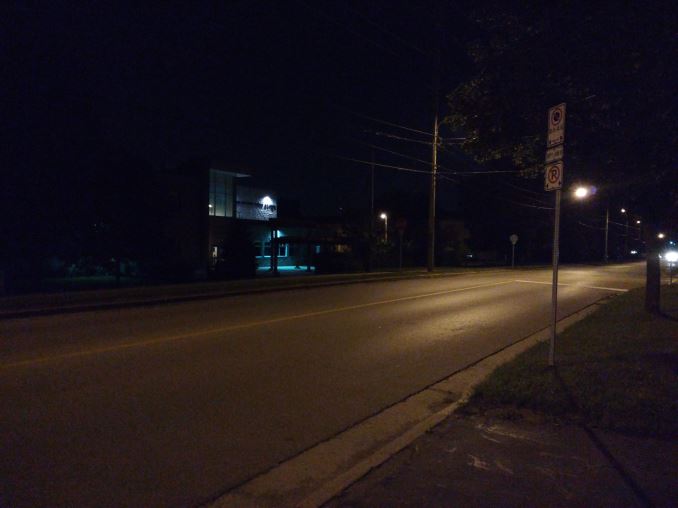The Moto G (2015) Review
by Brandon Chester on August 19, 2015 8:00 AM EST- Posted in
- Smartphones
- Mobile
Camera
One of the most notable improvements to the 2015 Moto G is its new rear-facing camera. The 2014 Moto G used Sony's IMX179, while the 2015 model adopts IMX214. The sensor size increases from 1/3.2" to 1/3.06" and the resolution increases from 8MP to 13MP. The aperture is also much wider, moving from F/2.4 to F/2.0, which can help offset the lower sensitivity of the smaller pixels. An overview of the Moto G's cameras can be found in the chart below.
| Camera Specifications | |||
| Moto G (2015) | |||
| Front Camera | 5MP (2560x1920) |
||
| Front Camera - Sensor | S5K5E2 (1.12 µm, 1/5") |
||
| Front Camera - Max Aperture | F/2.2 | ||
| Rear Camera | 13.0MP (4224x3400) |
||
| Rear Camera - Sensor | Sony IMX214 (1.12 µm, 1/3.06") |
||
| Rear Camera - Focal Length | 3.6mm (26mm eff) | ||
| Rear Camera - Max Aperture | F/2.0 | ||
While the Moto G lacks the voice coil motor from the Nexus 6 which is needed to enable OIS, the rest of the camera stack is effectively identical. The one difference on paper is the Moto G's shorter focal length which will give images a wider field of view.
Coincidentally, the move from IMX179 to IMX214 is the exact same change made between the Nexus 5 and Nexus 6. Whatever differences there are between the image quality of the 2015 Moto G and the Nexus 6 in good lighting rests primarily in the hands of their image signal processors. The Nexus 6 will obviously have a low light advantage due to its inclusion of OIS to lengthen shutter times, and we'll get to the low light differences after covering image quality with generous lighting.

In this daylight scene the Moto G performs very well. The exposure is very good, although I feel that it underexposed slightly while the Nexus 6 overexposed slightly. The Nexus 6 definitely has an edge when it comes to the sharpness of grass and foliage, as well as the preservation of textures such as the walls of the building and the pavement of the road. It's also worth noting that there's some lens distortion occurring on the Moto G which is causing color fringing along the white edges of the building windows, although at a normal viewing size it's barely noticeable. I think the Nexus 6 took an overall better photo, but only slightly better, with the Moto G doing a better job than any other mid-range device I've tested during the day.

Low light image quality is where things start to fall apart on the Moto G. While it's difficult to see in the small preview above, looking at the full size image reveals a great deal of color noise throughout the entire image, which doesn't exist on the Nexus 6. The Moto G took a 1/15s exposure, while the Nexus 6 was longer at 1/12s. 1/12s actually isn't very long for a device with OIS, and the difference in ISO value was not very large between the two devices either which means that Motorola's lacking quality has more to do with a simple lack of chroma noise reduction more than anything else. Chroma noise is by far the most distracting type of artifact in photos, and unfortunately it makes the Moto G unsuitable for photography in low light.
Video Quality
Video recording is a great test of a device's ISP as there's only a very short timespan to do processing on each frame that is captured. Since the 2015 Moto G and the Nexus 6 use the same image sensor this allows us to take a look at the differences in video quality between the ISPs in Snapdragon 410 and Snapdragon 805.
The Moto G records 1080p video at 30fps. Video is encoded with an average bitrate of 17Mbps using the H.264 high profile. For this comparison I limited the Nexus 6 to 1080p rather than UHD recording to make it an apples to apples comparison.
The most obvious advantage the Nexus 6 has is the stability of the video. While one might think this is due to the inclusion of OIS, the Nexus 6 isn't using the OIS for stabilization, and this is really just a case of superior EIS enabled by the superior ISP. As for the video quality itself, it's clear that the Nexus 6 is sharper across the frame and has greater detail on the various types of foliage in the area. The Nexus 6 also manages a better exposure, with the Moto G's video being too dark, with muted and just generally inaccurate colors. It appears that like the low light photo scene, the Moto G's video recording abilities are hampered by its ISP.
WiFi Performance
Like almost all of the low end and mid range devices I've tested recently, the Moto G ships with support for 802.11n on the 2.4GHz band. This single spatial stream implementation has a max link speed of 72Mbps.

The Moto G's WiFi speed is roughly the same as all other mid range devices. The Zenfone 2 is once again an exception to the rule, but I don't think anyone buying a device like the Moto G will have adopted an 802.11ac router at this point anyway due to cost reasons. I really hope we start seeing 5GHz support in mid range 802.11n phones though, rather than the ever increasingly crowded 2.4GHz band.






















90 Comments
View All Comments
Cod3rror - Wednesday, August 19, 2015 - link
I wish Motorola hadn't released two different versions (1GB / 2GB). I knew what would happen and what I expected is exactly what happened... almost all retailers and carriers in Europe/UK are stocking only the 1GB version and 2GB is nowhere to be found. Plus, because of the weak Euro, the 2GB version, if ordered from Motorola UK, comes out at 300 euro, which is very expensive. But don't get me wrong, even if it cost almost the same, the retailers and carriers would still stock the cheaper version.dan.swain - Saturday, September 12, 2015 - link
I agree with you, My wife has the Moto G 2015 16GB. Got it from Moto website the sales experience was terrible but I couldn't just buy the 16Gb in a shop so frustration ensued. The phone itself is great though, my wife can get multiple days out if it. At just over £200 it seemed a better deal than £200 Apple wanted for a refurbished IPhone 5c.wurizen - Wednesday, August 19, 2015 - link
It seems like this review confirms my suspicion of the new Moto G 2015 regarding the back cover flush gate. Feeling the back cover of a phone inch forward or push inwards when gripping it is a sign of a cheap phone to me. And we know that this is a cheap, budget phone, but, the Moto G 2014 doesn't have this issue. I am also looking at the profile picture of the Moto G 2015 and it looks bulkier than the Moto G 2014. Or it seems bulkier because the removable back cover of the 2015 is not halfway but below the Power and Volume buttons. Whereas, the Moto G 2014's back cover is exactly halfway from front to back, so it goes halfway up from the Power and Volume buttons making the phone--on a design perspective--look and feel balanced!What makes me sad is that I don't think Motorola had to sacrifice this decrease in "Phone Feel" and "Phone Ergonomics" or "Phone Design." Whatever you wanna call it.
I mean, did the design of the Moto G 2015 change because Motorola wanted it to be waterproof? Or, did Motorola purposely make a fatter Moto G 2015 so people will buy their other more expensive phones? Let the conspiracy theories begin!
My other gripe is that Best Buy, which is the only store I know in the U.S. that carries the Moto G unlocked version doesn't even have the new Moto G 2015 on display so customers can feel and hold it in their hands. I mean, imagine Samsung or Apple doing this? It would never happen. Yet, Motorola is letting Best Buy not have a display version. I also asked if they had the phone on sale and if they could open a box and let me hold one. But, they said that they didn't have any available. I then asked if they had sold out and they said, yes.
Also, there is no white version available at Best Buy and no 2 GB/16 GB variant available. Just the 1GB RAM and black one.
Can someone tell me why this is? What kind of marketing scheme is at work here?
Demon-Xanth - Thursday, August 20, 2015 - link
The reason why no 2/16 variant is that they are basically sold out everywhere. I'm guessing production focused on the black 1/8 due to anticipated demand. They aren't mythical devices. Just selling like cold beer at a county fair. Yes, I will be replacing my ATT XT1045 with a retail 2/16 when I can. The only problems I've had have been I'd like more RAM, a better camera, less "extra apps", and updates that aren't delayed until the second coming of christ. This covers all of them.stlc8tr - Wednesday, August 19, 2015 - link
"I don't think anyone buying a device like the Moto G will have adopted an 802.11ac router at this point anyway due to cost reasons."An AC router is roughly $75 on Amazon. It's not exactly a huge outlay so I think more points should be deducted for the lack of 5Ghz support. The 2.4Ghz band can be very crowded so being limited to only 2.4Ghz is a serious flaw, IMO.
Moto1 - Wednesday, August 19, 2015 - link
Dude, its 179$. Seriously?stlc8tr - Thursday, August 20, 2015 - link
Yes, I'm serious. In my neighborhood, there are so many 2.4Ghz WiFi networks that using my 2.4Ghz WiFi is hit or miss. I can't even use a Chromecast as the streaming times out half the time.So I avoid any devices that are 2.4Ghz only.
neogodless - Wednesday, August 19, 2015 - link
As this is a phone, could you comment on the speaker quality at all? It sounds like it still has stereo speakers like the 2014 model. Are they the exact same?hans_ober - Wednesday, August 19, 2015 - link
They're not stereo, bottom is a loudspeaker.neogodless - Tuesday, August 25, 2015 - link
That's too bad! The 2014 had stereo. In the search for "no compromises" including stereo speakers, I ended up with a Nexus 6.